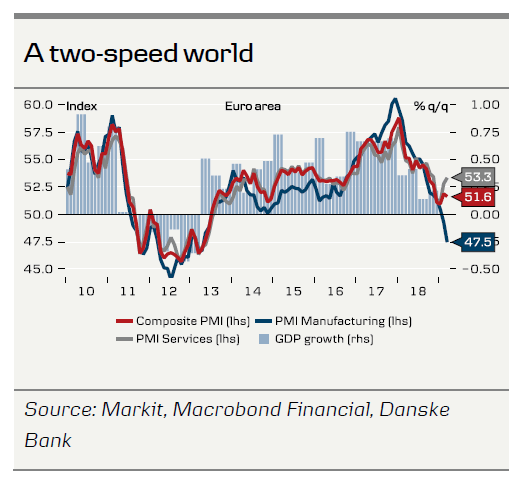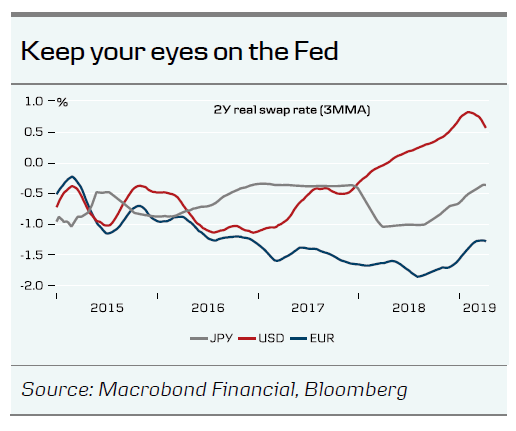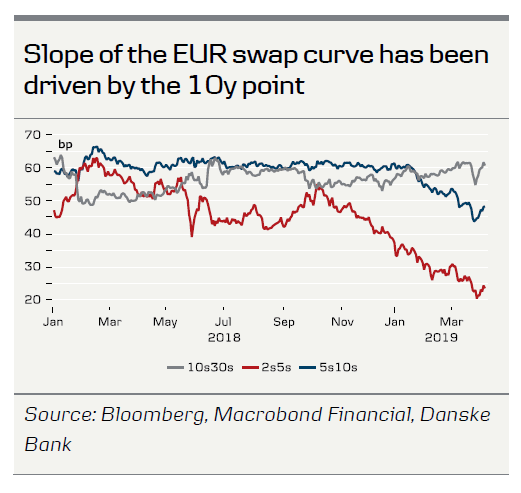- The ECB confirmed its ‘low-for-longer’ narrative at last week’s Watchers conference.
- We expect Draghi to repeat his ‘delayed, not derailed’ inflation message, thereby no new policy signals from the ECB. However, we expect Draghi to strike an overall cautious tone and the ECB to keep its downside risks assessment on growth.
- The economic indicators are yet to show a convincing pickup but positively some stabilisation in indicators (except in the German manufacturing sector and core inflation) has been observed, which we expect Draghi to acknowledge.
- We do not expect TLTRO3 modalities to be announced next week (not until June). We expect questions on a tiering-system but no additional colour to the discussion compared to last week comments from chief economist Peter Praet.
Cautious stance
The ECB kept its downside risk assessment on growth at the last governing council meeting (GC), while launching a new series of TLTROs and extending forward guidance. The ECB keeping its downside risk assessment while announcing policy measures has not been seen before often, which clearly points to awareness of and concern about the outlook. The March minutes showed that a case was made to change the risk assessment after the lower projections. That said, we still expect the ECB to keep its downside risk assessment, reflecting particularly weak manufacturing, which is still to show a pickup. On the positive side, the recent Chinese PMI pointed to an improved global cycle in the near future. Worryingly, though, the minutes said ‘that growth might not be mean-reverting, as typically assumed in projections’, pointing to China amongst others.
Tiering system and TLTRO3 modalities
We do not expect TLTRO3 modalities until June. We believe the verdict is still out on how favourable the ECB wants to make the operations and more time is needed for this. According to the communication so far, the main refinancing operation rate plays a crucial role in the incentive structure, without further colour of how this is structured.
We also expect markets to be disappointed about additional colour on a potential tiering system. In our ECB Watchers conference: is a tiering system really the answer? and our Government Bonds Weekly we outline why we do not expect a tiering system to be announced. However, given Peter Praet’s comments last Thursday we expect Draghi to face questions on the format and timeline of a potential tiering system. We expect Draghi to acknowledge the discussion of a tiering system, but as part of a discussion on how to mitigate the side-effects of the negative deposit rates.
We find it important to stress that we cannot rule out a tiering system at this stage and markets are right by assigning a non-zero probability to this given the comments from Draghi and Praet. However, we reiterate that the important lesson here is that ECB’s ‘lowfor- longer’ narrative is dominating and a discussion on a tiering system shows ECB’s willingness to use all instruments, as it is wary of the situation in the euro area.
Low market-based inflation pricing amid no hike on our forecast horizon
Inflation market pricing, measured by forward inflation swaps, stands c. 15bp lower compared with the GC meeting in March. The 2y2y and 5y5y inflation swap troughed at worryingly low levels of 1.03% and 1.32%, respectively, last week and have since then recorded a small rebound to 1.08% and 1.36% currently. Interestingly, the ECB attributes the recent repricing to a rising negative inflation risk premium (-67bp in five years) as the survey-based inflation measure remains broadly stable. However, we note that the most prominent survey gauge, the Q1 update of the survey of professional forecasters, is set to be released to the GC ahead of the meeting and if the survey points to deteriorating inflation expectations, from the current 1.82%, the ECB may open the door for more easing. Previously, when the longer-term SPF was at 1.77% in Q1 15, the ECB started QE. A similar move is expected to trigger an even more dovish reaction from the ECB. The SPF publication is due for release on 11 April.
As the inflation market pricing and EONIA pricing are strongly correlated with first rate hike pricing (measured by number of months to first rate hike), we need to see a significant pickup in market-based inflation expectations (in turn on the back of a pickup in economic data) before we can actively trade the first rate hike in outright terms.
Lower growth near-term – inflation delayed, not derailed
The downward revision of the staff projections at the March meeting was larger than we and markets had expected. The revisions, which were of a similar size as in the run up to the PSPP announcement in 2015, led to the ECB announcing its third round of targeted liquidity operations and postponing the first rate hike guidance, as a building worry of the slowdown becoming more structural has emerged.
Since the March meeting, only four weeks ago, we have seen some stabilisation in forward looking indicators such as Ifo, ZEW etc. However, the important German PMI manufacturing and inflation data disappointed, euro area growth likely remained subdued in Q1 19 and indicators point to a quarterly growth of 0.2% (in line with the ECB’s baseline). Overall, the PMIs paint a two-speed picture of the economic momentum. While the service sector rebounded in signs of strengthening domestic demand, manufacturing is painting a dour picture. Particularly, the Germany manufacturing sector is suffering from the global trade channel, albeit the rise in Chinese data may point to easing headwinds in the (German) manufacturing sector in the future.
The ECB still expects a pickup in growth and in turn inflation figures in a classical textbook (output gap) approach, which points to a loss of growth momentum that implies a later and more subdued pickup in inflation. We agree with this assessment, albeit our core inflation profile is slightly more dovish than the ECB’s profile staff projection suggests. The March disappointing core inflation figure of 0.8% was to a large degree driven by seasonal factors due to the timing of Easter (service price inflation declined to 1.1%). That said, the tight labour market conditions and strong wage growth are yet to translate into core inflation. The missing transmission from wages to consumer prices is becoming an increasing worry for the ECB as Draghi also pointed to structural changes during the March press conference. However, so far we believe the ECB to stick to its mantra that ‘the sustained convergence of inflation towards the 2% aim has been delayed rather than derailed’.
FX fatigued
The weak PMI, the collapse in market-based inflation expectations and the turnaround in the ECB’s communication at last month’s meeting as well as during the Watchers conference have put focus on the potential need for further ECB easing. The discussion has so far centred on forward guidance, TLTRO modalities and a tiered deposit system – none of which has the potential to substantially weaken the EUR in our view. A signal of more QE or rate cuts could do the trick, but that is not for the April meeting, but could come later depending on how the incoming data play out.
The recent development in short-term real interest rates (illustrated by 2Y OIS real swap rates) highlights the current asymmetric outcome space for EUR/USD with respect to relative monetary policy. The Fed can tighten, as it did last year, when it pushed the real rate about 100bp higher, and Fed can ease, as it has done this year, where the short-term real rate has dropped about 15bp. In contrast, the ECB does not seem to have an answer to the 35bp rise in the real rate since the start of 2018.
For EUR/USD, the coming months will be a tug of war, between the development in global risk sentiment and carry. The recent bout of better Chinese data provides some comforting support for EUR/USD, however, on the other hand, carry on short EUR/USD still sits above 3% in a 1Y FX forward, albeit down from 3.45% last year following the repricing of the Fed. We forecast EUR/USD at 1.13 in 3M and highlight that if the ECB starts to look into QE or rate cut options, we could see a dip to 1.10 in the short term.
Still ECB support for European fixed income
The focus in the fixed income markets is set to turn to the economic outlook, as the effort to find news about the details of the new TLTRO and the potential of a tiering system for deposit rates is unlikely to be fruitful.
Hence, the ECB will hardly rock the boat and the market will conclude once again that any rate hikes are very far away. The first 10bp hike in the depo rate is currently priced in H1 21 and after the tiered rates discussion started at the ECB Watchers conference last week, the market now sees a very small probability that rates could be cut in late 2019. This is unlikely to change next week with no new details of a possible tiering system. We also expect that Bunds will remain supported and 10Y Bund yields are expected to continue to trade in a -10bp to +5bp range after the meeting.
We also hold on to the view that the ‘low-for-longer’ rhetoric including the tiering discussion has created a very supportive carry or hunt for yields environment in the Eurozone and recommend to overweight periphery and semi-core in the government bond market. The EUR swap curves have steepened after the tiering rates discussion last week. We expect that especially the 5s10s flattening will start again as the pivotal point on the curve has moved out on the curve





















